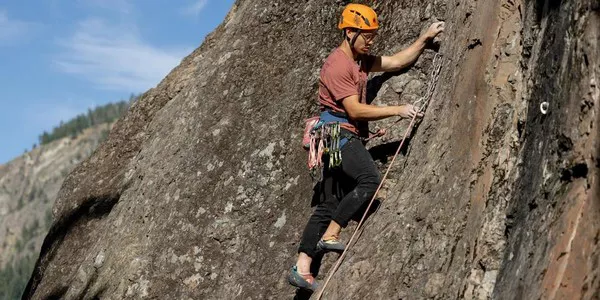Climbing, as a sport, captivates enthusiasts with its blend of physical prowess, mental acuity, and sheer determination. From scaling towering rock faces to conquering indoor walls, climbers constantly seek to refine their techniques to navigate challenging routes efficiently. Among the array of techniques climbers employ, “smearing” stands out as a fundamental skill essential for tackling a diverse range of climbing surfaces. In this comprehensive guide, we delve into the intricacies of smearing, unraveling its mechanics, benefits, and practical applications for climbers of all levels.
Understanding Smearing: The Essence of Friction Climbing
At its core, smearing refers to the technique of using friction rather than holds to support body weight on the climbing surface. Unlike relying solely on handholds and footholds, smearing involves utilizing the surface area of the climbing shoe to maximize contact with the rock or wall. This technique is particularly crucial in situations where traditional holds are sparse or nonexistent, demanding climbers to adapt and rely on their ability to generate friction between their shoes and the climbing surface.
Mechanics of Smearing: Finding Balance and Precision
Executing a successful smear requires a delicate balance of body positioning, weight distribution, and precise foot placement. To begin, climbers must position their feet squarely on the surface, ensuring maximum contact area between the shoe rubber and the rock. Unlike edging, where climbers rely on the narrow edge of their shoe, smearing involves utilizing the entire sole to distribute weight evenly and maximize friction.
Achieving balance is paramount in smearing, as even slight shifts in weight can significantly impact stability. Climbers must engage core muscles and maintain a controlled center of gravity to prevent slipping or losing traction. By keeping the body close to the wall and employing subtle adjustments in weight distribution, climbers can optimize their smearing technique and ascend with confidence.
Benefits of Smearing: Versatility and Adaptability
Mastering the art of smearing offers climbers a myriad of benefits, enhancing their versatility and adaptability on various climbing surfaces. Unlike relying solely on handholds and footholds, smearing empowers climbers to tackle routes featuring smooth, featureless sections where traditional holds are scarce. This versatility proves invaluable in outdoor climbing scenarios, where natural rock formations may present challenging terrain devoid of conventional handholds.
Moreover, smearing fosters a deeper connection between climbers and the climbing surface, requiring heightened sensitivity and proprioception. By attuning themselves to the nuances of friction and surface texture, climbers can exploit subtle irregularities in the rock to secure stable footholds and progress efficiently. This heightened awareness not only enhances climbing proficiency but also cultivates a deeper appreciation for the intricacies of the natural environment.
Practical Applications: Smearing Techniques for Success
Incorporating smearing into one’s climbing repertoire necessitates practice, patience, and a willingness to embrace new challenges. As climbers venture onto routes featuring smoother surfaces or sparse holds, mastering smearing techniques becomes indispensable for overcoming obstacles and reaching new heights.
Several key strategies can aid climbers in honing their smearing skills:
1. Weight Distribution: Focus on distributing weight evenly across the entire foot, avoiding excessive pressure on any particular area. By maintaining a balanced stance, climbers can optimize friction and prevent slippage.
2. Body Positioning: Keep the body close to the wall, with hips aligned beneath the feet for optimal stability. Minimize outward leaning or overextension, as this can compromise balance and hinder smearing effectiveness.
3. Foot Placement: Pay careful attention to foot placement, seeking out textured areas or subtle features on the climbing surface to maximize friction. Experiment with different angles and orientations to find the most secure footholds.
4. Dynamic Smearing: Embrace dynamic smearing techniques to navigate challenging sequences or transitions between holds. By leveraging momentum and controlled foot movements, climbers can propel themselves upward with confidence.
5. Sensitivity Training: Develop sensitivity to surface texture and friction by practicing smearing on a variety of terrain types. Experiment with different shoe rubbers and climbing surfaces to refine tactile feedback and proprioceptive awareness.
By incorporating these strategies into their training regimen, climbers can elevate their smearing proficiency and tackle a wide range of climbing challenges with finesse and precision.
Conclusion
In the dynamic world of climbing, mastery of smearing represents a pivotal milestone in a climber’s journey towards excellence. By harnessing the power of friction and embracing the nuances of surface interaction, climbers can unlock new realms of possibility and surmount obstacles previously deemed insurmountable.
Aspiring climbers are encouraged to embrace the challenge of mastering smearing, viewing it not as a mere technique but as a gateway to newfound confidence, versatility, and connection with the vertical world. Through dedication, practice, and a relentless pursuit of improvement, climbers can elevate their skills to unprecedented heights, forging a path towards greater mastery and fulfillment in the exhilarating pursuit of vertical adventure.

